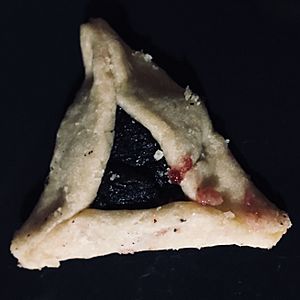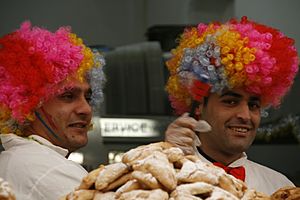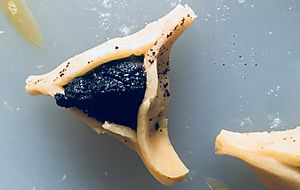Hamantash facts for kids
 |
|
| Alternative names | Oznei Haman |
|---|---|
| Type | Cookie or pastry |
| Place of origin | Ashkenazi Jewish communities |
| Variations | Filling: traditionally poppy seed or prune |
A hamantash (plural: hamantashen) is a special triangular pastry. It's a type of cookie or pastry with a yummy filling inside. Jewish people, especially those from Ashkenazi communities, enjoy hamantashen.
These treats are strongly connected to the Jewish holiday of Purim. The name "hamantash" comes from Haman, who was the bad guy in the Purim story. In Hebrew, hamantashen are also called oznei Haman, which means "Haman's ears."
Traditionally, hamantashen dough was made with yeast. Later, with the invention of baking powder, the dough became more like a cookie. To make them, a filling is placed in the middle of a round piece of dough. Then, the sides are folded to create a triangle shape.
The oldest and most traditional fillings are poppy seed paste or prune jam. Today, you can find many sweet fillings. Popular choices include apricot, raspberry, date, chocolate, and cheese. The dough can be firm like a shortbread cookie or soft like a yeast bread.
Contents
What is a Hamantash?
A hamantash is a triangular-shaped cookie or pastry. It is filled with sweet or savory ingredients. This treat is very popular during the Jewish holiday of Purim. People often bake them at home or buy them from bakeries.
Why the Name Hamantash?
The name hamantash comes from Haman. He was the villain in the Book of Esther from the Bible. Haman tried to harm the Jewish people. The hamantash pastries are said to represent Haman's defeat.
The Yiddish word tash means "pouch" or "pocket." So, "Haman's pockets" might refer to the money Haman offered. He wanted to destroy the Jewish people. In Hebrew, tash means "weaken." This could mean the weakening of Haman's power.
In Israel, hamantashen are called oznei Haman. This means "Haman's ears" in Hebrew. This name also refers to Haman, the defeated enemy.
Why the Three-Sided Shape?
The reason for the hamantash's unique three-sided shape is a bit of a mystery!
- One old story says Haman wore a three-cornered hat.
- Another idea is that it represents the weakening of Haman's strength. This happened when he recognized the importance of the Three Patriarchs.
- Some think the shape looks like dice from an ancient game. Haman used dice to pick the day to harm the Jews.
- A simpler idea is that it's just a traditional way to fold dough. This method creates a pocket for the filling.
Delicious Fillings for Hamantashen
Hamantashen can be filled with many tasty things.
Sweet Fillings
Sweet fillings are the most common.
- Traditional choices include poppy seed paste and prune jam.
- Other popular sweet fillings are apricot jam and date paste. Date is especially loved in Israel.
- You can also find hamantashen with raisin, apple, cherry, fig, and chocolate fillings.
- Some modern sweet fillings include dulce de leche, halva, caramel, and cheese.
Savory Fillings
In recent years, savory hamantashen have become popular. These are often made at home. You can also find them in Jewish bakeries.
- Popular savory fillings include pizza, spinach and feta cheese.
- Other options are lamb, potato, or different kinds of cheese.
- Savory hamantashen are similar to other Jewish pastries. These include knish and bourekas.
How Hamantashen are Made
Sweet hamantashen usually have a dough made with butter. Sometimes, oil is used instead. The dough can be crumbly like shortbread. It can also be soft like a cake.
The dough is made with flour, eggs, sugar, and butter or oil. Flavorings like vanilla or lemon zest are often added. Baking powder or baking soda helps the dough rise. The dough is mixed gently. This keeps it from becoming tough.
After mixing, the dough rests in the refrigerator. Then, it is rolled out. It should be about 1/8 to 1/4 inch thick. Round shapes are cut from the dough. An egg wash is often brushed on the dough. This helps seal the edges. It also makes the baked hamantash shiny and golden.
The filling is placed in the center of each dough circle. The bottom and top two corners are folded inward. This creates the triangle shape. The filling stays partly visible. Sometimes, hamantashen are frozen briefly after shaping. This helps prevent the filling from leaking out. Finally, they are baked in an oven until golden. After baking, they might be dusted with powdered sugar. Some are dipped in chocolate or topped with sprinkles.
Savory hamantashen are made similarly. However, they use different fillings. The dough for savory ones might be like a pie crust or puff pastry. It usually has less sugar than sweet hamantash dough.
Hamantashen in Israel

In Israel, hamantashen are known as "oznei haman." They are the most popular cookie sold in bakeries. This happens in the weeks leading up to Purim every year. Both large chains and small bakeries offer many kinds.
Just like in other countries, poppy seed is the most popular filling. Chocolate is second, and date filling is third. Jam fillings are not as common in Israel as they are in America. Israeli bakeries now offer fancy versions. These include marzipan or gluten-free options. This shows how much Israel's food scene has grown. They like to update traditional dishes.
Images for kids
See also
 In Spanish: Hamantash para niños
In Spanish: Hamantash para niños




